The Green Dining Blog
Welcome to Our Blog: Discover the Benefits of Arecanut Leaf Plates
At R2S GREENWAVE , we’re passionate about promoting sustainability and innovation through our range of eco-friendly products. Our blog is your go-to resource for all things related to arecanut leaf plates—a revolutionary alternative to traditional disposable tableware.
Here, you’ll find insightful articles that delve into the many benefits of arecanut leaf plates, from their environmental impact to their unique production process. Whether you’re looking for inspiration for your next event, interested in the science behind our products, or simply curious about sustainable dining solutions, our blog offers valuable information and practical tips.
Join us on this journey towards a greener future as we explore the versatility, sustainability, and elegance of arecanut leaf plates.
The Sustainable Choice: Why Arecanut Leaf Plates are the Future of Eco-Friendly Dining

In today’s world, sustainability is not just a buzzword—it’s a lifestyle. As more people become aware of the environmental impact of their choices, the demand for eco-friendly products is on the rise. One such product gaining popularity is the arecanut leaf plate. These plates are made from the naturally fallen leaves of the Areca palm tree, making them an excellent alternative to plastic and styrofoam.
Why Choose Arecanut Leaf Plates?
Arecanut leaf plates offer a range of benefits that make them stand out:
-
- 100% Natural: Made without chemicals, these plates are safe for both the environment and your health.
- Biodegradable: Unlike plastic, these plates decompose naturally within 60-90 days.
- Durable: Strong enough to hold hot, cold, and liquid foods without leaking or breaking.
- Aesthetic Appeal: The natural look adds a rustic, eco-chic touch to any event.
A Step Towards a Greener Future
By choosing arecanut leaf plates, you’re not only reducing your carbon footprint but also supporting sustainable practices. These plates are a perfect choice for environmentally conscious consumers looking to make a positive impact.
How Arecanut Leaf Plates Are Transforming the Event Industry
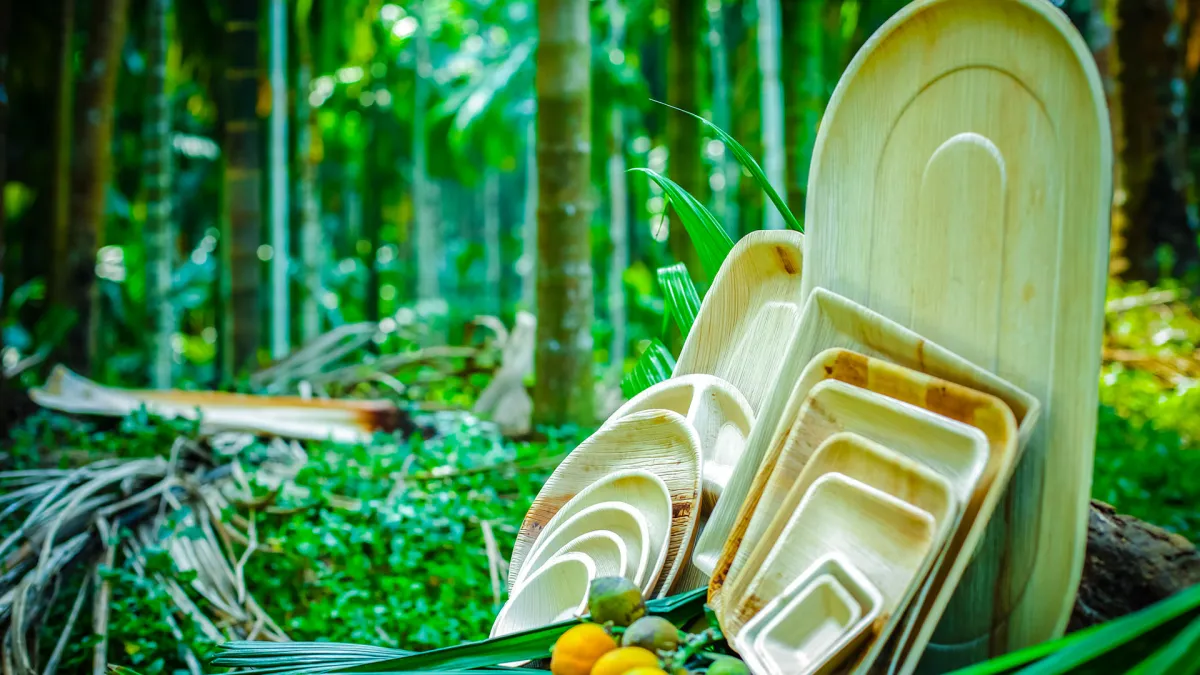
The event industry is notorious for generating large amounts of waste, with single-use plastic being a major contributor. However, with the increasing demand for sustainable alternatives, arecanut leaf plates have emerged as a game-changer. These plates are eco-friendly, stylish, and functional, making them the perfect choice for green events.
Why Event Planners Love Arecanut Leaf Plates
- Versatility: Available in various shapes and sizes, they cater to different culinary needs, from appetizers to main courses.
- Customizable: For large events, these plates can be customized with logos or designs, adding a personal touch.
- Environmentally Responsible: Using these plates significantly reduces waste, aligning with the values of eco-conscious clients.
Making Your Event Eco-Friendly
Incorporating arecanut leaf plates into your event planning not only enhances the aesthetic but also demonstrates a commitment to sustainability. It’s a small change that makes a big difference, ensuring that your event leaves a positive legacy.
The Journey of Arecanut Leaf Plates: From Palm to Plate

Have you ever wondered how arecanut leaf plates are made? The process is as natural as the product itself, involving minimal intervention and no harmful chemicals. Let’s take a closer look at the journey of these eco-friendly plates from palm to plate.
Step 1: Collection of Fallen Leaves
The process begins with the collection of naturally fallen areca palm leaves. These leaves are gathered from plantations without harming the trees, making the process sustainable.
Step 2: Cleaning and Sanitizing
The collected leaves are thoroughly cleaned and sanitized to remove any dirt or debris, ensuring that they are safe for use.
Step 3: Heat Pressing
The clean leaves are then placed in molds and heat-pressed into various shapes and sizes. This process is entirely natural, without the use of chemicals, dyes, or bonding agents.
Step 4: Quality Check and Packaging
After molding, the plates undergo a quality check to ensure they meet the required standards. Once approved, they are packed and ready for distribution.
A Truly Natural Product
The entire process of making arecanut leaf plates is rooted in sustainability, from the collection of fallen leaves to the final product. These plates are a testament to the power of nature and human ingenuity, offering a truly natural and eco-friendly alternative to traditional disposable tableware.
Arecanut Leaf Plates: The Perfect Blend of Tradition and Modernity

In a world dominated by mass-produced plastic products, arecanut leaf plates stand out as a unique blend of tradition and modernity. Rooted in the ancient practice of using natural materials for everyday needs, these plates have been adapted to meet the demands of contemporary life, offering a sustainable solution for modern dining.
The Traditional Roots
The use of leaves as plates dates back centuries in various cultures, where they were valued for their simplicity and connection to nature. Arecanut leaf plates continue this tradition, using naturally fallen leaves to create functional, eco-friendly tableware.
Meeting Modern Needs
While rooted in tradition, arecanut leaf plates are perfectly suited to modern lifestyles. They are:
- Convenient: Single-use and disposable, they are ideal for busy lives and large gatherings.
- Stylish: Their natural look adds a touch of elegance to any table setting, making them popular for both casual and formal events.
- Eco-Friendly: In line with today’s environmental values, these plates offer a guilt-free alternative to plastic and styrofoam.
A Plate for Every Occasion
Whether you’re hosting a backyard barbecue, a wedding, or a corporate event, arecanut leaf plates provide a versatile and stylish solution. Their blend of tradition and modernity makes them a perfect choice for those who value sustainability without compromising on quality or aesthetics.
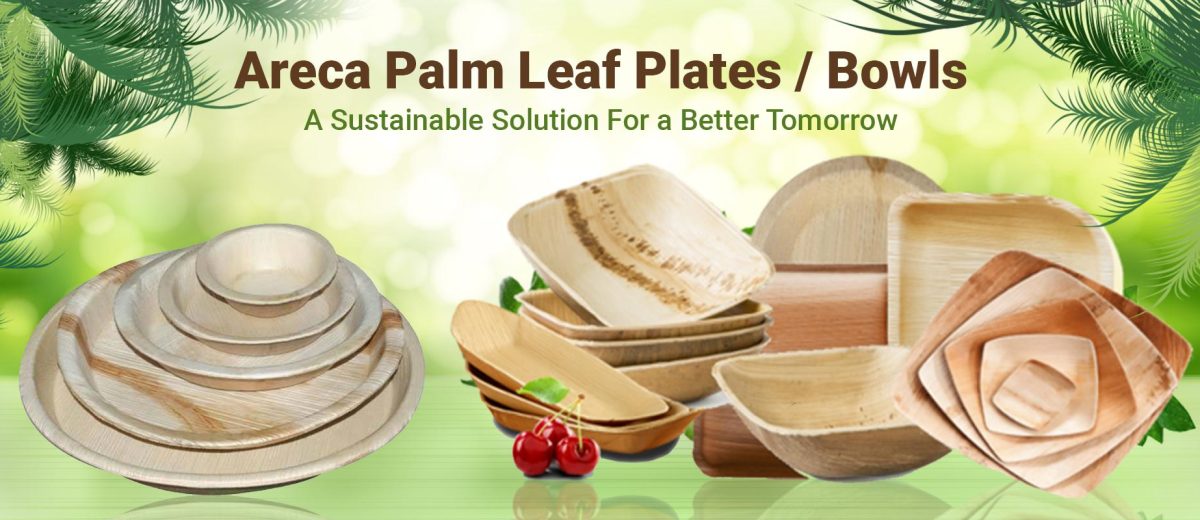
Global Areca Plates Market
The global areca leaf plates market is experiencing significant growth, driven by increasing environmental awareness and a shift towards sustainable products.
Market Projections:
Valuation: In 2022, the market was valued at approximately US$ 414.3 million.
Growth Rate: It is projected to grow at a compound annual growth rate (CAGR) of 5.4% from 2023 to 2031.
Future Valuation: By 2031, the market is expected to reach around US$ 658.1 million.
Environmental Concerns: The increasing global focus on reducing plastic waste and adopting eco-friendly alternatives is propelling the demand for biodegradable products like areca leaf plates.
Government Regulations: Many countries are implementing stringent regulations against single-use plastics, further boosting the adoption of sustainable tableware solutions.
Consumer Preferences: There is a growing consumer inclination towards organic and natural products, enhancing the market appeal of areca leaf plates.
Key Growth Drivers:
Environmental Concerns: The increasing global focus on reducing plastic waste and adopting eco-friendly alternatives is propelling the demand for biodegradable products like areca leaf plates.
Government Regulations: Many countries are implementing stringent regulations against single-use plastics, further boosting the adoption of sustainable tableware solutions.
Consumer Preferences: There is a growing consumer inclination towards organic and natural products, enhancing the market appeal of areca leaf plates.
Regional Insights
Asia-Pacific: As a major producer of areca leaves, this region holds a significant share of the market and is expected to continue its dominance due to abundant raw material availability and increasing local demand.
North America and Europe: These regions are witnessing substantial growth, attributed to rising environmental consciousness and supportive governmental policies promoting sustainable products.
Challenges:
Supply Chain Issues: Dependence on specific geographic regions for raw materials can lead to supply chain disruptions.
Cost Factors: Higher production costs compared to plastic alternatives may pose challenges in price-sensitive markets.
Opportunities:
Innovation: Developing new designs and enhancing the durability of areca leaf plates can attract a broader consumer base.
Market Expansion: Exploring untapped markets and increasing awareness about the benefits of areca leaf plates can drive future growth.
In summary, the global areca leaf plates market is poised for steady growth through 2031, fueled by environmental initiatives and changing consumer preferences towards sustainable products.
Areca Leaf Plates vs. Paper Plates: Which One Is the Greener Choice for the Planet?
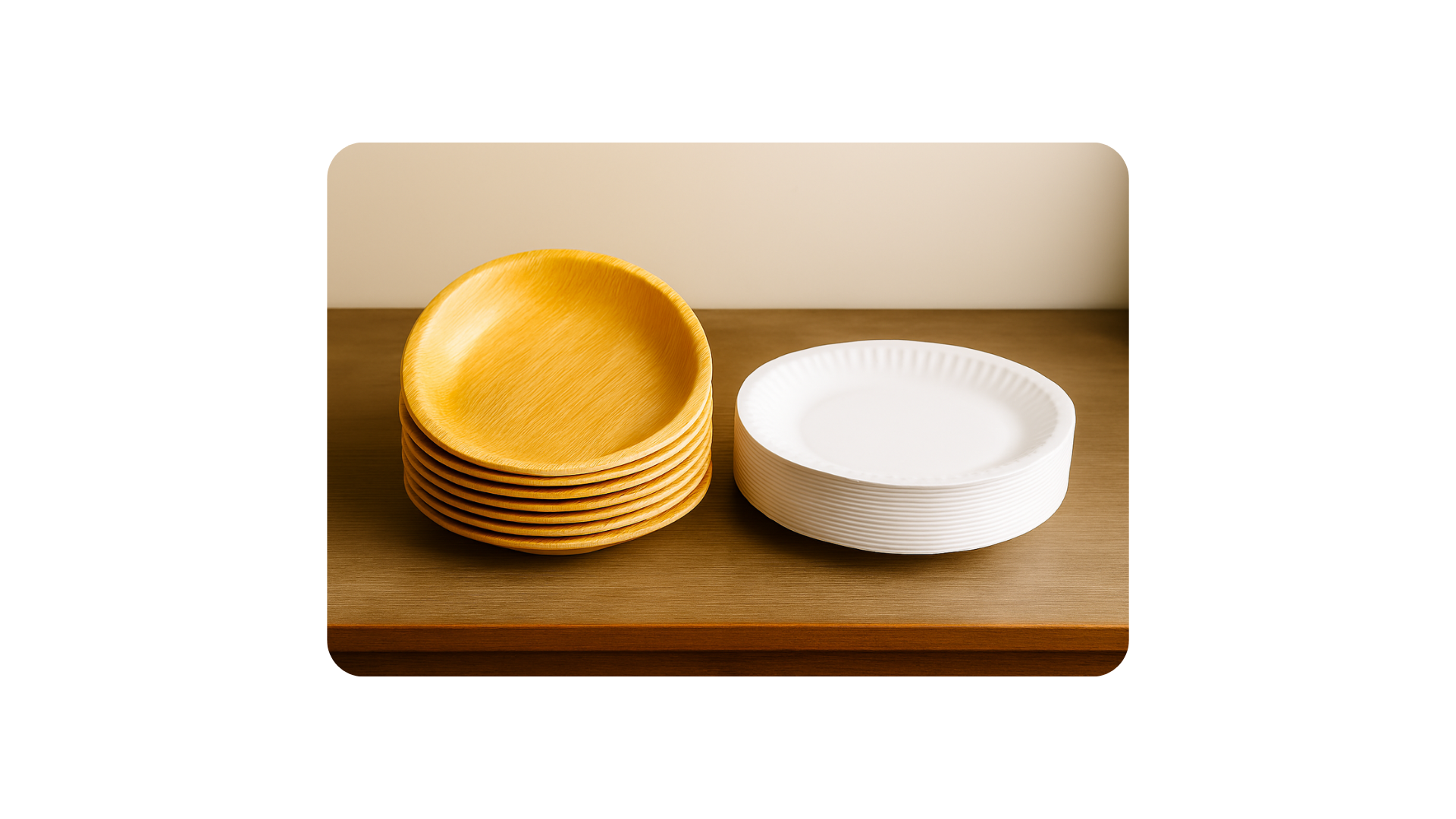
When it comes to eco-friendly disposable plates, two popular choices dominate the conversation: areca leaf plates and paper plates. Both are marketed as biodegradable alternatives to plastic or Styrofoam, but the question remains — which one is truly sustainable and better for the planet? In this blog, we’ll break down the environmental impact, production process, and end-of-life disposal of both options to help you make the best choice for a greener lifestyle.
What Are Areca Leaf Plates?
Areca leaf plates are made from naturally fallen leaves of the Areca palm tree. No trees are cut down during production — the leaves are simply collected, cleaned, heat-pressed into shape, and sterilized. This process requires minimal water and zero chemicals, making these plates one of the most eco-friendly dinnerware options available today.
Because they are sturdy, leak-proof, and heat-resistant, areca plates are often used in weddings, catering events, restaurants, and eco-conscious households. Best of all, they are 100% biodegradable and compostable, breaking down within 6–8 weeks without releasing toxins.
What Are Paper Plates?
Paper plates, on the other hand, are usually made from wood pulp or recycled paper. While they sound environmentally friendly, the reality is more complex. Most paper plates are coated with plastic or wax to make them water-resistant, which means they are not easily biodegradable or compostable.
Producing disposable paper plates also requires cutting down trees, consuming large amounts of water, and using bleaching agents or chemicals to make them food-safe. Even when made from recycled material, the production process often adds to carbon emissions and deforestation concerns.
Comparing the Environmental Impact
1. Raw Materials
Areca Leaf Plates: Made from naturally shed leaves — no deforestation.
Paper Plates: Require trees to be cut down, contributing to forest loss and wildlife habitat destruction.
2. Production Process
Areca Plates: Minimal energy, no chemicals, very low carbon footprint.
Paper Plates: Energy-intensive, involves water consumption, bleaching, and coating with chemicals.
3. Durability and Usability
Areca Leaf Plates: Strong, heat-resistant, can hold hot curries and oily foods without leaking.
Paper Plates: Weaker, often become soggy with liquids unless coated (which makes them less eco-friendly).
4. End-of-Life Disposal
Areca Plates: Fully compostable and biodegradable; return to soil as organic matter.
Paper Plates: If coated, they are not recyclable or compostable. They often end up in landfills where they take years to decompose.
Health and Safety
Another factor often overlooked is food safety. Areca leaf dinnerware is made without chemicals or artificial coatings, so it’s safe to serve both hot and cold foods. In contrast, paper plates often contain wax, plastic, or even PFAS (forever chemicals) that can leach into food when exposed to heat.
If you’re looking for non-toxic biodegradable plates, areca plates are the clear winner.
Cost and Availability
Some argue that paper plates are cheaper and more widely available. While this is true in the short term, the growing demand for sustainable products has made areca leaf plates wholesale options more accessible. Today, eco-conscious caterers, restaurants, and individuals are shifting towards eco-friendly disposable plates even if they cost slightly more, because the long-term environmental benefits far outweigh the small price difference.
Which One Should You Choose?
If your priority is convenience alone, paper plates may seem like the easier option. But if you’re serious about sustainable living, reducing waste, and making a positive impact on the planet, areca leaf plates are the better choice by far. They are:
Conclusion
When comparing areca leaf plates vs. paper plates, it’s clear that one is far more sustainable than the other. Areca plates require no deforestation, minimal processing, and decompose naturally without harming the environment. On the other hand, most paper plates are resource-intensive to produce, often coated with plastics, and harmful to both the planet and human health.
As individuals, businesses, and communities become more aware of eco-friendly alternatives to disposable plates, the shift toward areca leaf dinnerware is gaining momentum worldwide. Next time you host an event or look for sustainable packaging solutions, remember: choosing biodegradable areca leaf plates over paper plates is a small decision that makes a big difference for our planet.
Areca Vs Bagasse Vs Paper Plates: Which disposable plate is truly eco-friendly?
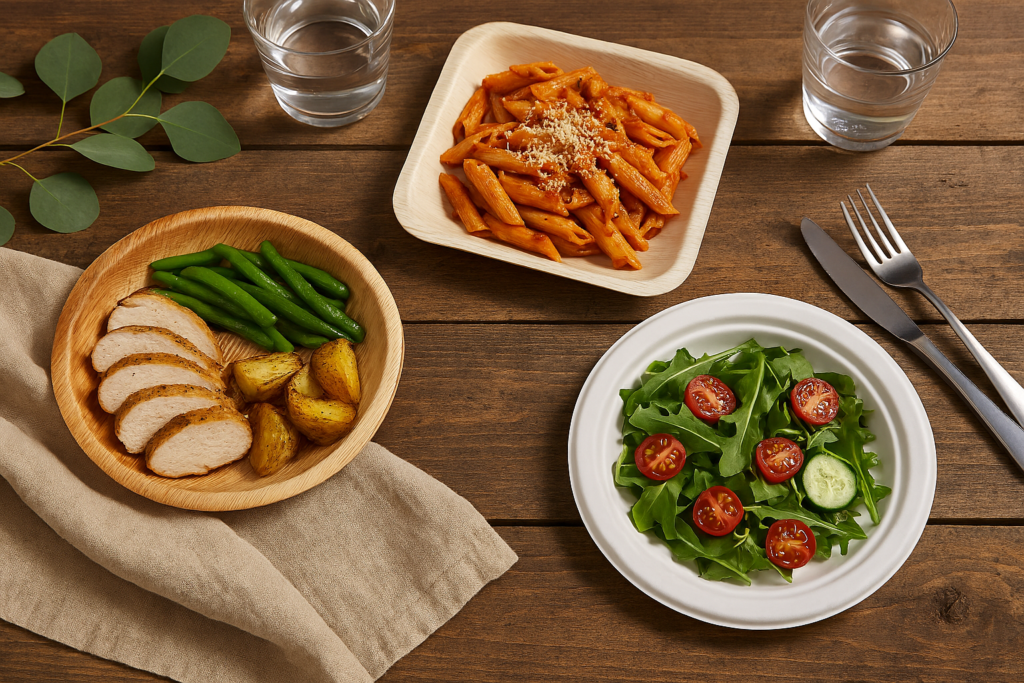
As the world shifts toward sustainable living, the demand for eco-friendly disposable plates has never been higher. With increasing bans on single-use plastics, businesses and individuals are exploring greener options such as areca leaf plates, bagasse plates, and paper plates. Each of these alternatives is marketed as biodegradable and compostable, but which one is truly the most eco-friendly dinnerware?
Let’s dive into a detailed comparison of these three popular options based on their raw materials, production process, durability, and environmental impact.
What Are Areca Leaf Plates?
Areca leaf plates are made from naturally shed leaves of the Areca palm tree. No trees are cut down — the leaves are collected, cleaned, and molded into shape using heat and pressure. This process uses minimal water and no chemicals, making areca plates one of the purest forms of biodegradable tableware.
They are sturdy, heat-resistant, and can hold oily or liquid foods without leakage. Being 100% compostable plates, they return to the soil within weeks, leaving behind no toxic residue.
What Are Paper Plates?
Paper plates are perhaps the most familiar option. They are made from wood pulp or recycled paper, and often coated with wax or plastic to prevent leakage. While marketed as eco-friendly, most paper plates are not easily compostable or recyclable due to these coatings.
The production of paper plates also contributes to deforestation, high water usage, and carbon emissions, especially when virgin wood pulp is used.
Comparing Eco-Friendly Plates: Areca vs. Bagasse vs. Paper
To understand which is the best choice, let’s break it down into categories.
1. Raw Materials
Areca Leaf Plates: Made from naturally fallen palm leaves. No cutting of trees, no waste.
Bagasse Plates: Made from sugarcane residue (a byproduct), reducing agricultural waste.
Paper Plates: Made from trees or recycled paper; often contributes to deforestation.
2. Production Process
Areca Plates: Simple, low-energy process with no chemicals.
Bagasse Plates: Requires pulping, water, and energy; involves chemical treatments.
Paper Plates: Energy-intensive, uses water and bleaching chemicals, plus plastic/wax coatings.
3. Durability & Usability
Areca Leaf Plates: Strong, heat-resistant, safe for hot and oily foods.
Bagasse Plates: Durable, suitable for hot food, slightly less sturdy than areca.
Paper Plates: Weak, easily soggy without coatings; not suitable for heavy meals.
4. End-of-Life Disposal
Areca Plates: 100% biodegradable and compostable in home compost bins.
Bagasse Plates: Compostable but often require industrial composting for faster breakdown.
Paper Plates: Coated plates are not recyclable or compostable; end up in landfills.
Environmental Impact
When considering eco-friendly dinnerware, areca leaf plates have the lowest environmental impact. Their production requires minimal resources and they return to the soil quickly.
Bagasse plates are a good second option since they make use of waste materials, but the energy and chemicals used in processing slightly reduce their sustainability score.
Paper plates, though familiar and cheap, are the least eco-friendly. Their production often involves cutting down trees, and their coating makes them difficult to compost.
Health & Safety Factor
Food safety is another important point. Areca plates are made without any additives or toxins, making them safe for serving hot curries, oily foods, and even desserts.
Bagasse disposable plates are safe too but may sometimes contain trace chemicals from processing.
Paper plates often contain wax, plastic, or harmful chemicals like PFAS, which can leach into food when exposed to heat.
Cost and Availability
Areca Leaf Plates: Slightly more expensive than paper, but increasingly available through eco-friendly suppliers and exporters.
Bagasse Plates: Moderately priced, widely used by restaurants and food chains.
Paper Plates: Cheapest and widely available, but environmentally costly.
Final Verdict: Which Plate Is Truly Eco-Friendly?
If you want the most sustainable option, areca leaf plates come out on top. They are:
Made from natural fallen leaves (zero deforestation).
Produced with no chemicals and low energy.
100% biodegradable and compostable within weeks.
Strong, reusable for light purposes, and safe for all kinds of foods.
Bagasse plates are a close second, offering a good balance of sustainability and durability. Paper plates, while convenient, are the least eco-friendly and should be avoided whenever possible.
Conclusion:
When comparing areca vs. bagasse vs. paper plates, the winner is clear: areca leaf dinnerware is the most eco-friendly, followed by bagasse biodegradable plates, while paper plates lag far behind.
As businesses, caterers, and households move toward eco-friendly disposable plates, the choice we make today will shape a more sustainable tomorrow. Choosing biodegradable areca plates is not just a practical decision — it’s a step toward protecting our planet. 🌍
How Importers Prevent Fungus in Areca Leaf Plates During Rainy Season: Storage & Packaging Tips
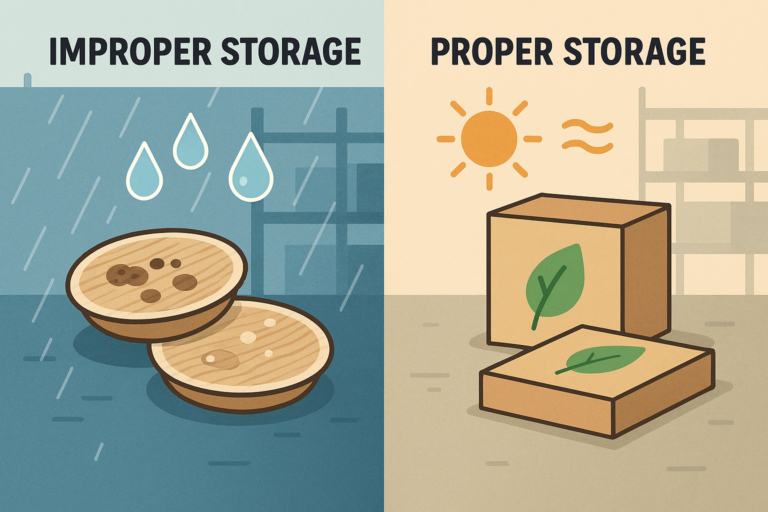
When it comes to eco-friendly dinnerware, areca leaf plates are one of the most sustainable and attractive alternatives to plastic. Lightweight, biodegradable, and naturally stylish, they are widely used for catering, restaurants, events, and home dining. But one persistent challenge for exporters and importers of areca plates is their vulnerability to fungus during the rainy season or when stored in high-humidity conditions.
At R2S GREENWAVE, we specialize in manufacturing and exporting premium areca leaf dinnerware that meets international standards. Over the years, we’ve seen how humidity, improper storage, and poor packaging can reduce shelf life. In this blog, we’ll share insights on how importers prevent fungus in areca plates during the rainy season, along with proven storage and packaging tips to keep your products fresh, safe, and market-ready.
 Why Areca Leaf Plates Are Prone to Fungus in Humid Conditions
Why Areca Leaf Plates Are Prone to Fungus in Humid Conditions
Areca plates are made from naturally shed palm leaves, which are pressed into shape without chemicals or coatings. While this makes them 100% biodegradable and compostable, it also means they can absorb moisture from the environment.
During the rainy season or in coastal humid climates (such as Dubai, Jeddah, Dammam, and Muscat), the combination of heat and moisture creates a perfect environment for mold and fungal growth. Even when plates are safe for food use, visible mold spots or warping can lead to customer rejection.
That’s why humidity control and fungus prevention are critical at every stage—from manufacturing in India to storage by Gulf importers.
 Preventive Measures at the Manufacturing Stage
Preventive Measures at the Manufacturing Stage
Proper Drying: At R2S GREENWAVE, plates undergo sun-drying and hot-air oven drying to reduce moisture content below 12%. This significantly minimizes fungal risk.
UV or Steam Sterilization: To kill surface microbes, some exporters apply UV light or steam treatment before packing.
Strict Quality Sorting: Plates with cracks, excess fiber, or uneven drying are removed because they are more prone to mold during storage.
By ensuring plates leave the factory with low moisture content, we set the foundation for safe long-term storage.
📦 Packaging Tips for Rainy Season Exports
Importers often emphasize that packaging is as important as production. Here’s how moisture is controlled during transit:
Vacuum sealing or shrink-wrapping: Keeps plates airtight and moisture-free.
Silica gel or desiccant sachets: Absorbs excess humidity inside cartons.
Poly-lined cartons: Double-layered or laminated cartons resist moisture penetration during shipping.
Fumigated containers with desiccant poles: Prevent container sweat (condensation) during long sea voyages.
At R2S GREENWAVE, we customize packaging solutions for buyers depending on their destination climate. Gulf importers, in particular, prefer poly-wrapped cartons with desiccants because of high summer humidity.
10 Creative Ways to Use Areca Leaf Plates Beyond Dining: Eco-Friendly Ideas You’ll Love
In today’s world, where sustainability and creativity go hand in hand, areca leaf plates are gaining recognition not only as eco-friendly dinnerware but also as versatile items that can be reused in innovative ways. Made from naturally fallen areca palm leaves, these plates are biodegradable, compostable, and chemical-free, making them a sustainable alternative to single-use plastic and paper.
At R2S GREENWAVE, we’ve seen how areca leaf products are transforming events, homes, and businesses. Beyond their use at the dining table, these plates can be repurposed in creative ways that align with zero-waste living and sustainable practices. Let’s explore 10 unique ways to use areca leaf plates beyond dining.
1. Eco Friendly Garden Planters "
"
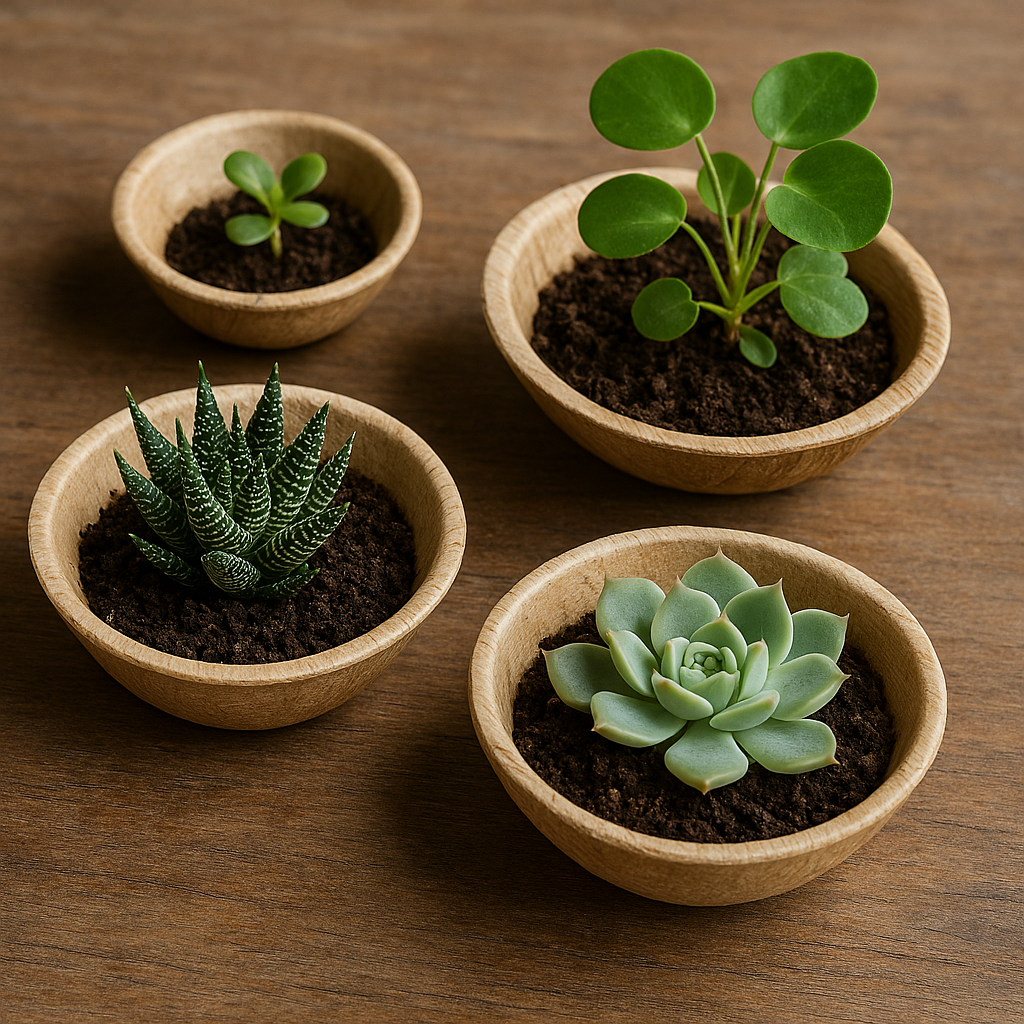
One of the simplest and most rewarding uses is to repurpose areca plates as seed starters or plant pots. They naturally decompose, making them perfect for gardening. Once seedlings grow, you can directly plant the whole plate into the soil — no plastic required.
2. Stylish Home Decor Items 🏡
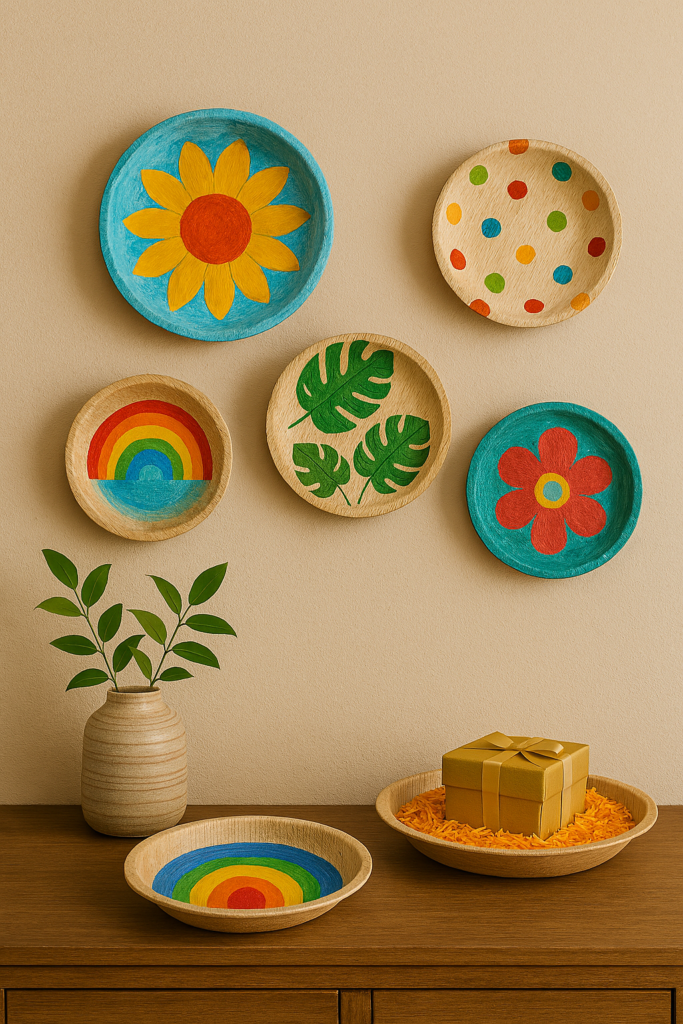
From wall hangings to rustic candle holders, areca plates can be painted, carved, or decorated into chic home accents. Their earthy texture blends perfectly with eco-friendly home decor trends.
3. Natural Craft Supplies for Kids 

Parents and teachers love areca leaf plates as craft materials. They are safe, biodegradable, and provide a sturdy surface for painting, cutting, or shaping into creative art projects. It’s a fun way to introduce children to sustainable living.
4. Festive and Wedding Decor 🎉

In Indian weddings and global eco-conscious events, areca plates are often reused as flower holders, rangoli bases, or decorative trays. Their natural elegance makes them a sustainable choice for festive decor.
5. Pet-Friendly Food Bowls 🐾

Eco-conscious pet owners can use areca leaf bowls and plates as temporary feeders for their pets. Since they are chemical-free and compostable, they are safe and sustainable compared to plastic bowls.
6. DIYA Candle and Soap Molds 

Crafters are increasingly using areca leaf dinnerware as molds for candles and soaps. Their durability and natural design make them excellent for small-scale handmade products.
7. Sustainable Gifting Ideas 🎁
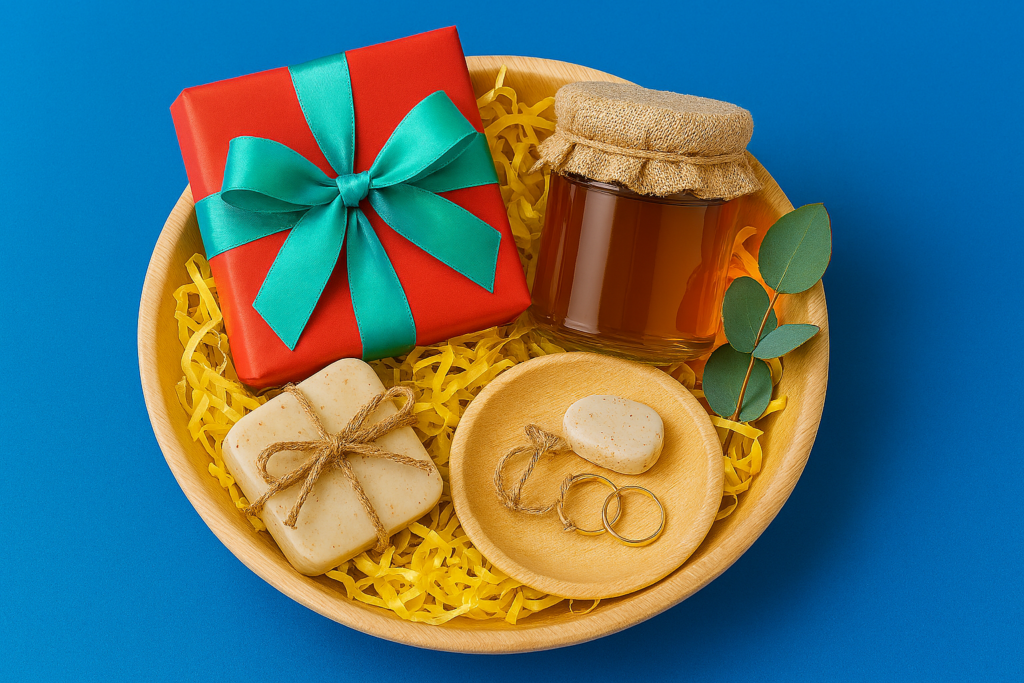
Replace plastic gift boxes with beautifully decorated areca plates filled with goodies like sweets, dry fruits, or handmade crafts. They serve as both packaging and a useful eco-friendly item for the recipient.
8. Party Props and Serving Trays 🍽️

For themed parties, areca plates can be creatively reused as props, serving trays, or rustic backdrops for buffets. Event planners appreciate how these biodegradable plates add both charm and sustainability to celebrations.
9. Compostable Food Packaging 🌍
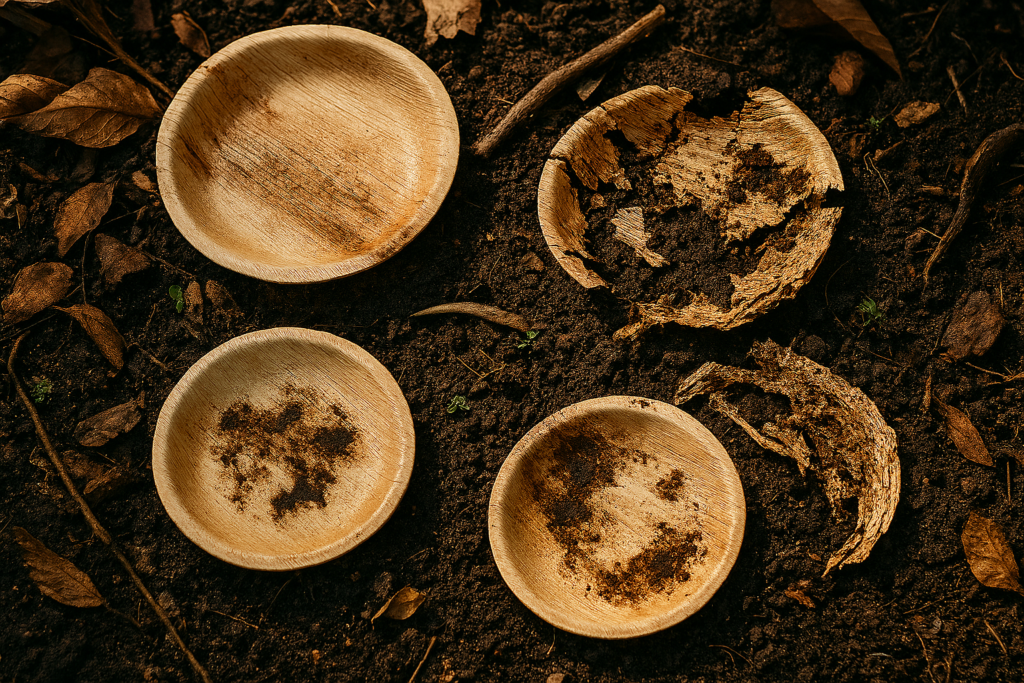
Cafés, bakeries, and catering businesses are experimenting with areca plates as packaging material. Unlike paper or plastic, they are strong, leak-resistant, and compostable — aligning with eco-friendly business practices.
10. Creative Wall Art & Displays 🎨
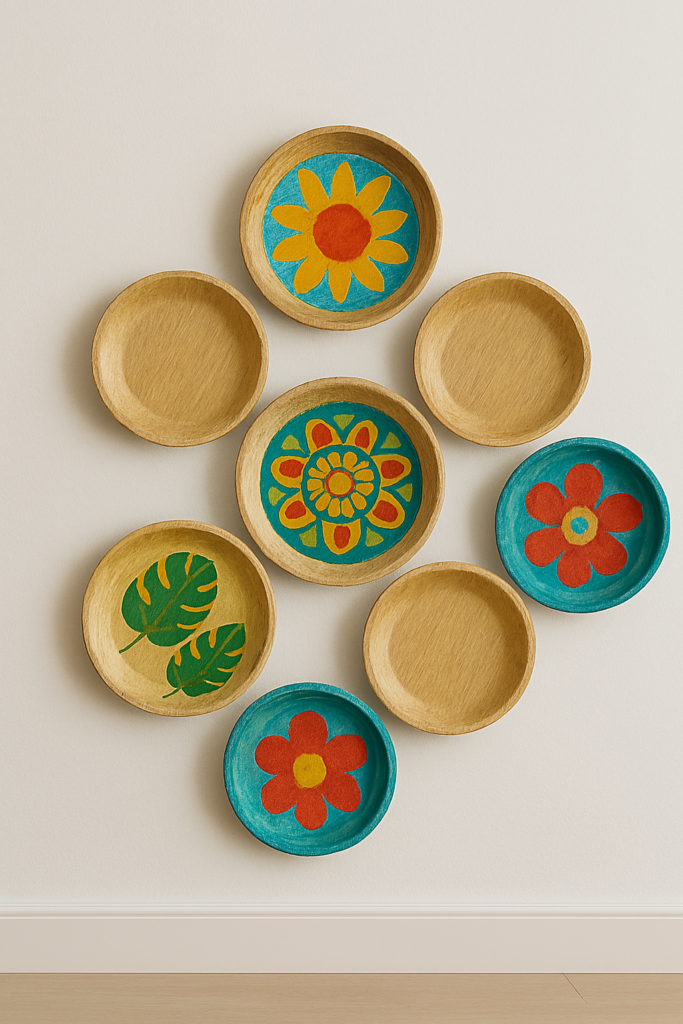
Artists and eco-conscious designers are turning areca leaf plates into stunning wall installations. Painted, woven, or arranged in patterns, they transform into sustainable artwork that adds character to homes and offices.
Why Choose Areca Plates for Sustainable Living?
The beauty of areca leaf dinnerware lies in its zero-waste lifecycle. From dining to repurposing, every stage of its use contributes to reducing plastic waste and promoting a greener lifestyle.
At R2S GREENWAVE, we believe in empowering individuals, caterers, and event planners to adopt sustainable tableware while also inspiring them to reuse creatively. By choosing areca leaf plates, you are not only making an eco-friendly choice but also contributing to a healthier planet.
Final Thoughts
Whether you’re a gardener, an artist, a parent, or an event planner, areca leaf plates offer countless possibilities beyond just serving meals. Their strength, versatility, and compostability make them a perfect partner in sustainable living.
If you’re ready to explore the world of eco-friendly dinnerware , R2S GREENWAVE is here to help. Together, let’s build a future where sustainability is both practical and inspiring.
The Hidden Lessons Every Eco-Friendly Brand Can Learn from Areca Leaf Plates
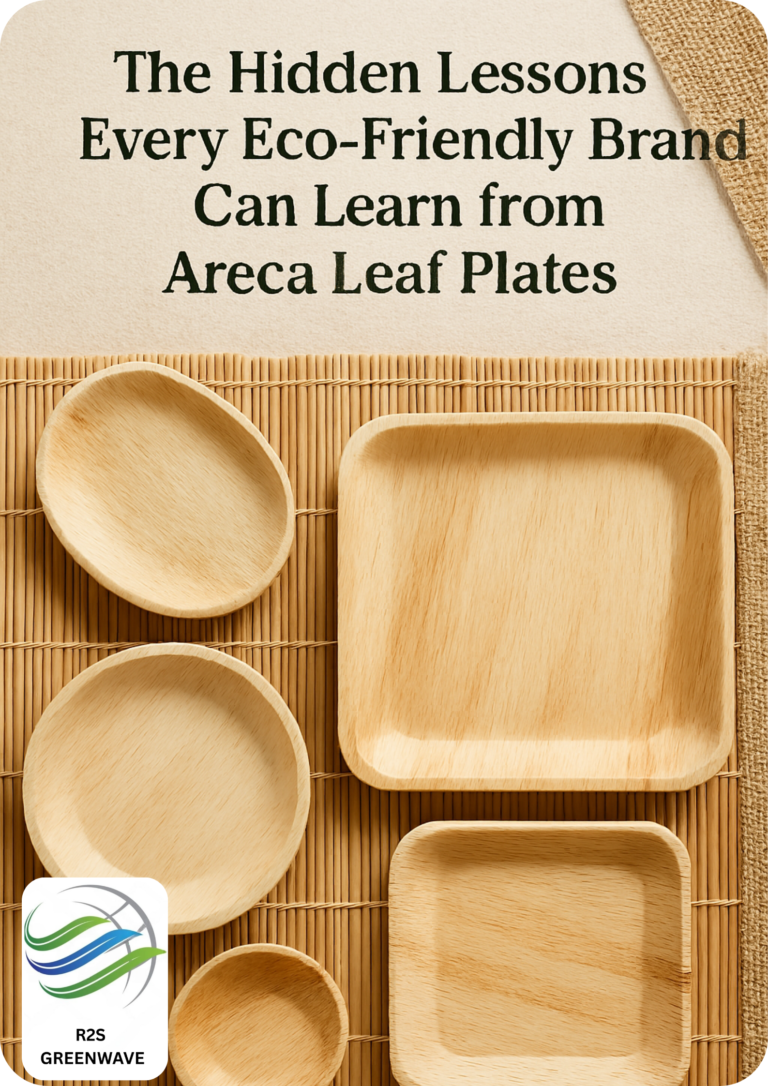
In the global movement toward sustainable living, few products have captured attention as quickly as areca leaf plates. Made from naturally fallen palm leaves, they tick all the right boxes—eco-friendly, biodegradable, renewable, and safe for food contact. Yet, their journey in international markets hasn’t always been smooth.
Some countries have welcomed them wholeheartedly, while others have introduced stricter regulatory hurdles. For eco-friendly entrepreneurs, policymakers, and sustainable product innovators, this story carries hidden lessons worth paying attention to.
Here are the five most important takeaways every green brand can learn from areca plates.
 Lesson 1: Sustainability Alone Isn’t Enough
Lesson 1: Sustainability Alone Isn’t Enough
 Lesson 1: Sustainability Alone Isn’t Enough
Lesson 1: Sustainability Alone Isn’t Enough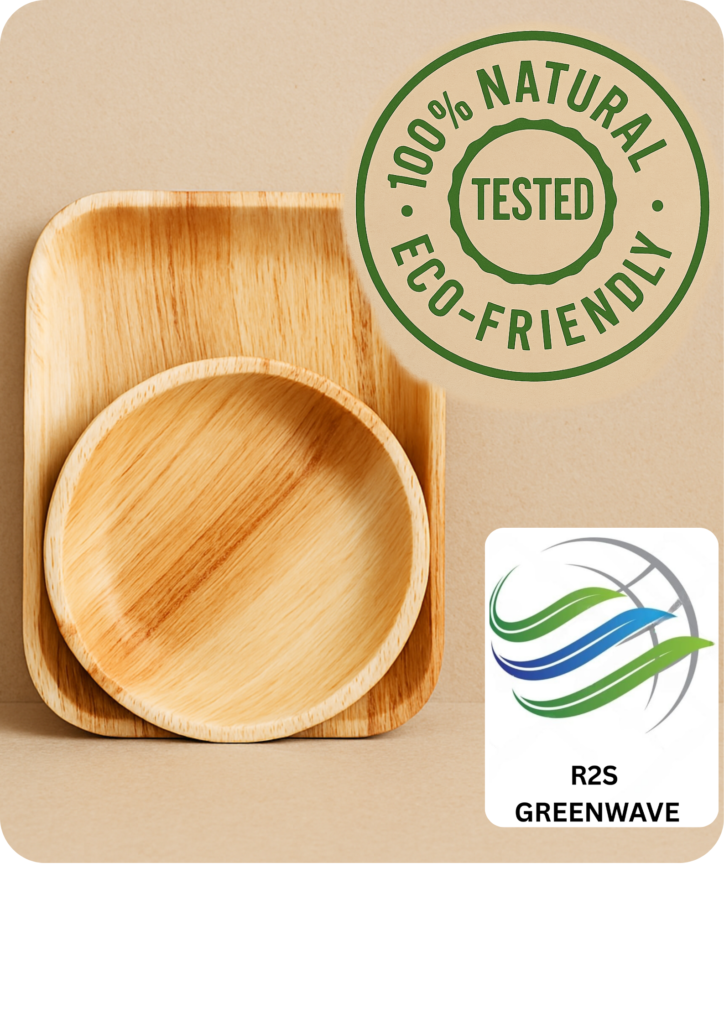
A product being natural or biodegradable isn’t enough to guarantee smooth entry into every market. Today’s global trade requires scientific validation, compliance with safety standards, and internationally recognized certifications.
Areca leaf plates, despite their eco-friendly origins, have faced regulatory challenges in regions where testing and documentation are prioritized over the “green story.”
👉 Takeaway for brands: Always back sustainability claims with data, compliance, and certifications. This builds trust with regulators, distributors, and conscious consumers alike.
 Lesson 2:Clear communication prevents misunderstandings
Lesson 2:Clear communication prevents misunderstandings
A surprising reason for the confusion around areca plates is the term itself. Many regulators and consumers have mistaken them for being derived from the areca nut (which is linked to health risks), when in reality, they are made from fallen leaves of the areca palm—a completely different raw material.
👉 Takeaway for brands: Never assume people understand your product. Educate clearly and consistently. Your packaging, marketing, and certifications should leave no room for doubt.
🌱 Lesson 3: Regulations Can Change Overnight
The global market for eco-friendly products is evolving fast. One year, a product may enjoy open acceptance; the next, new testing requirements or import restrictions may come into force.
Areca leaf plates are a classic example. While accepted widely in Europe and Asia, North America has imposed stricter standards, creating uncertainty for exporters.
👉 Takeaway for brands: Build resilience by staying informed, updating certifications, and planning for regulatory shifts. Proactivity is key to survival in green markets.
🌱 Lesson 4: Collaboration Strengthens Credibility

No eco-brand succeeds in isolation. When challenges arise—be it scientific doubts, policy shifts, or trade barriers—collaboration among manufacturers, exporters, researchers, and certification bodies becomes essential.
👉 Takeaway for brands: Collaboration builds credibility and collective influence. The stronger the network, the more resilient the eco-business ecosystem becomes.
🌱 Lesson 5: Diversification is Key to Longevity
Depending on a single product or market is risky. Areca plates have proven popular in weddings, restaurants, catering, and retail—but when one region tightens regulations, businesses that lack diversification struggle.
👉 Takeaway for brands: Explore multiple markets and multiple product lines. Resilience comes from spreading risk, not putting all resources in one basket.
 The R2S GREENWAVE Perspective
The R2S GREENWAVE Perspective
At R2S GREENWAVE, we believe the story of areca leaf plates is not a setback but an opportunity. Each challenge has only made us more determined to build robust, compliant, and future-ready eco-products.
Our approach is simple:
✅ Invest in rigorous testing and certification
✅ Communicate with transparency and clarity
✅ Partner with global distributors and collaborators
✅ Expand our portfolio beyond areca plates into holistic sustainable solutions
By doing so, we ensure that our customers and partners don’t just buy a product—they join a movement toward a truly circular, green economy.
🌏 Final Thoughts
The journey of areca plates highlights one powerful truth: sustainability must be matched with credibility.
For eco-friendly brands worldwide, the hidden lessons are clear—validate your claims, educate your audience, prepare for change, collaborate widely, and diversify smartly.
At R2S GREENWAVE, we see these lessons not as obstacles but as guiding principles to build a stronger, greener tomorrow.
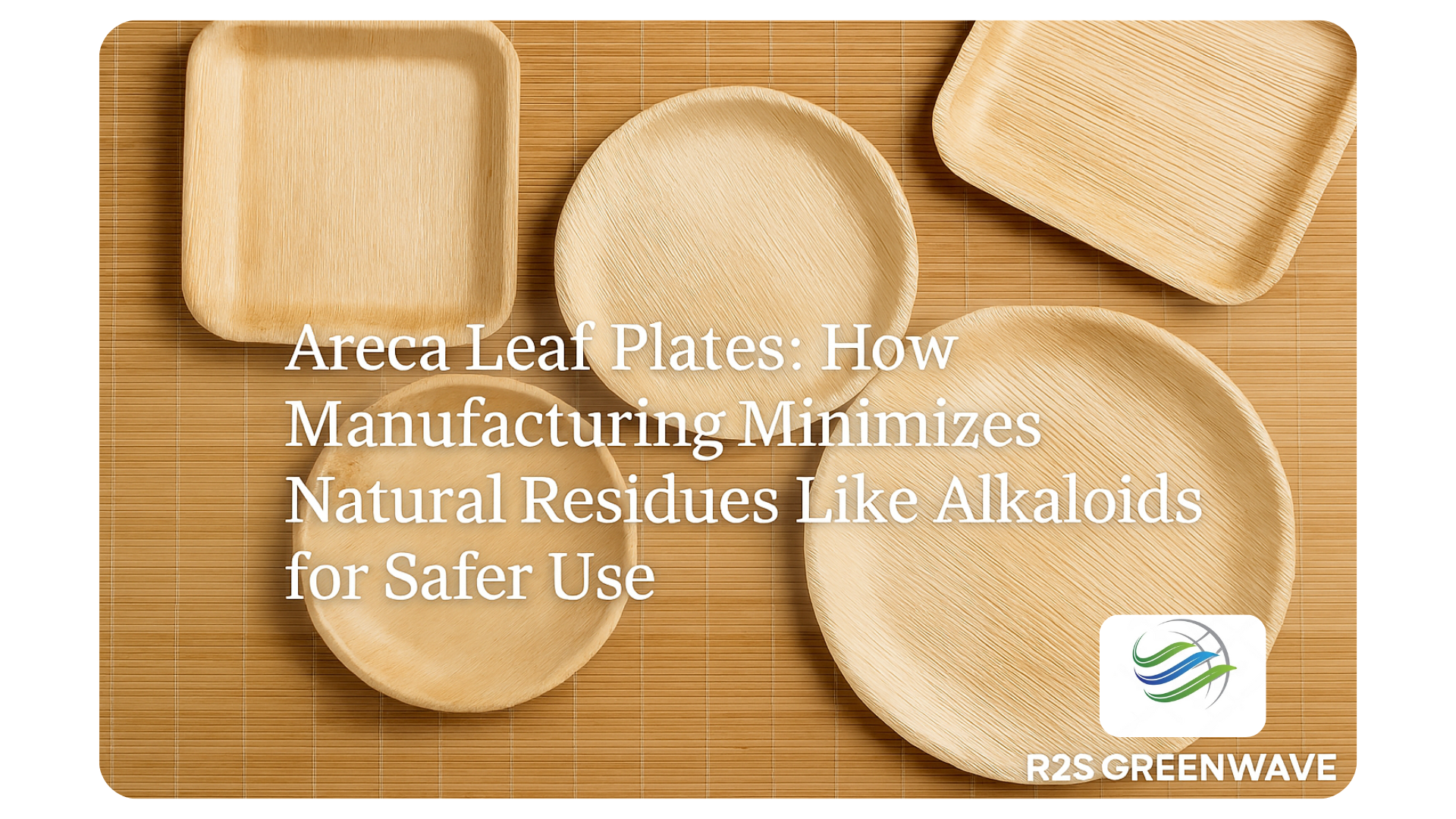
When it comes to eco-friendly alternatives in tableware, Areca leaf plates have carved out a significant place in global markets. Their natural origin, biodegradability, and elegant appeal make them a popular replacement for single-use plastics. But as with any product that comes into contact with food, questions about safety and residues are important. One such concern is the presence of natural alkaloids—compounds found in many plant leaves.
This is where the manufacturing process plays a critical role. Proper sourcing, cleaning, and heat pressing of Areca leaves ensures that potential natural residues like alkaloids are minimized, making these plates not only sustainable but also safe for everyday use. At R2S GREENWAVE, we believe that caring for the planet also means caring for the people who use our products—which is why we ask deeper safety questions and ensure our processes reflect global best practices.
 Why Natural Residues Are a Concern
Why Natural Residues Are a Concern
 Why Natural Residues Are a Concern
Why Natural Residues Are a ConcernPlant-based products, including Areca palm leaves, naturally contain compounds such as tannins, polyphenols, and sometimes alkaloids. While these compounds are part of the leaf’s natural defense system, prolonged or unregulated exposure in food contact items could raise questions about migration into food.
The truth is, most of these residues are reduced or eliminated during traditional processing steps like washing, sun drying, and heat pressing. Scientific migration studies and heavy metal screenings have consistently shown that Areca plates are safe for direct food contact, with compliance to major food safety standards like EU Regulation (EC) 1935/2004 and US FDA guidelines.
 How Manufacturing Minimizes Residues
How Manufacturing Minimizes Residues
 How Manufacturing Minimizes Residues
How Manufacturing Minimizes ResiduesThe manufacturing process of Areca leaf plates is thoughtfully designed to ensure hygiene, quality, and safety:
1. Leaf Collection & Sorting
Only naturally fallen, mature Areca palm leaves are collected. Leaves that are too young or damaged (which may contain more plant compounds) are discarded. This careful sorting reduces variability in chemical composition.
2. Washing to Remove Surface Compounds
Each leaf is thoroughly washed with clean water to remove dust, soil, and surface-level organic compounds. This step helps reduce extractables and natural residues that could otherwise transfer during use.
3. Sun Drying or Oven Drying
Drying plays a critical role. Moisture reduction not only prevents fungus formation but also reduces residual alkaloid activity. Studies on plant processing show that drying naturally degrades many of these compounds, making the leaf more stable.
4. Heat Pressing
The washed and dried leaves are heat-pressed into shape at temperatures above 120°C. This step is crucial: heat denatures many natural plant alkaloids and tannins, significantly lowering their extractability. It also sterilizes the product, ensuring it is hygienic for food contact.
5. Final Inspection & Packaging
Plates are visually checked for defects and then packed in moisture-controlled packaging, ensuring that they stay safe, clean, and ready for use.
 Evidence from Migration & Safety Tests
Evidence from Migration & Safety Tests
 Evidence from Migration & Safety Tests
Evidence from Migration & Safety TestsGlobally, Areca plates have been subjected to tests including:
Food Contact Migration Tests (EU & FDA protocols)
Heavy Metal Screening (lead, cadmium, arsenic, mercury—all within safe limits)
Microbiological Safety Tests (ensuring no harmful bacteria or fungi)
The results? Areca leaf plates consistently meet international safety standards, proving that the careful processing steps effectively minimize residues like alkaloids and make them safe for consumers.
 Why This Matters for Eco-Friendly Brands
Why This Matters for Eco-Friendly Brands
 Why This Matters for Eco-Friendly Brands
Why This Matters for Eco-Friendly BrandsIn an era where eco-friendly products are booming, consumers are no longer satisfied with just “green” claims. They want assurance of safety, quality, and scientific backing. By addressing concerns about natural residues transparently, brands build deeper trust.
At R2S GREENWAVE, we position ourselves not just as sellers of Areca plates but as a solution-driven eco-brand. We care enough to ask:
How safe are these products for long-term use?
What steps can reduce even trace levels of natural compounds?
How can we exceed—not just meet—global safety standards?
By raising and addressing these questions, we empower importers, distributors, and eco-conscious buyers with confidence in choosing Areca plates.
 The Bigger Picture: Safe, Sustainable, and Responsible
The Bigger Picture: Safe, Sustainable, and Responsible
 The Bigger Picture: Safe, Sustainable, and Responsible
The Bigger Picture: Safe, Sustainable, and Responsible
Areca leaf plates are more than just disposable dinnerware. They represent a sustainable lifestyle choice—a way to reduce plastic waste while connecting with nature. And when manufactured with care, they provide both eco-friendliness and food safety.
The lesson is clear: Sustainability and safety must go hand in hand. By refining processes that minimize natural residues like alkaloids, Areca plates stand as proof that plant-based products can be both safe and planet-friendly.
 Final Word
Final Word
 Final Word
Final WordThe journey from leaf to plate is not just about shaping dinnerware; it’s about shaping a safer, greener future. Thanks to careful manufacturing, Areca leaf plates minimize natural residues and pass strict global safety tests.
At R2S GREENWAVE, we’re proud to lead this movement—not only by offering eco-friendly plates but by committing to deeper scientific inquiry and global safety practices. Because true sustainability means caring about every detail, from the environment to the health of the people we serve.
References & Sources
European Commission – Food Contact Materials (Regulation EC 1935/2004)
US FDA CFR 21 §177.1520 – Olefin Polymers for Food Contact Applications
Food Packaging Forum – Plant-based Packaging Safety Assessment
ResearchGate: Food Safety Testing of Areca Leaf Plates (screenings and migration studies)



